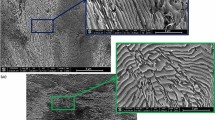Abstract
The structural and mechanical factors that control the torsion fracture behavior of cold-drawn eutectoid steel wires are examined. Two types of the fracture are identified; namely, flat- and cleavage-type. Torsion cracks are found to initiate in ferrite and propagate along the ferrite/cementite interface. The shear stress distribution within the wires is affected not only by the applied torque, but also by the residual stress. The maximum shear stress occurs halfway from center to the surface, where the cracks initiated. The growth of torsion cracks is sensitive to the orientation of cementite lamellas in pearlite grains. The influence of thermal history on the occurrence of cleavage fracture is ascertained, with the assistance of atom probe. It shows that the cleavage fracture results from a decrease in dislocation mobility, caused by thermally activated diffusion of carbon atoms into ferrite.











Similar content being viewed by others
References
Lefever I, D’haene U, Van Raemdonck W, Aernoudt E, Van Houtte P, Sevillano JG (1998) Wire J Int November: 90
Lee SK, Ko DC, Kim BM (2009) Mater Des 30:2919
Lee SK, Lee SB, Kim BM (2010) J Mater Process Technol 210:776
Zelin M (2002) Acta Mater 50:4431
Kanetsuk Y, Hirai Y, Ogawa R (1989) ISIJ Int 29:687
Tarui T, Nishida S, Yoshie A, Ohba H, Asano Y, Ochiai I, Takahashi T (1999) Nippon Steel Tech Rep 80:44
Park DB, Kang EG, Nam WJ (2007) J Mater Process Technol 187–188:178
Bae CM, Nam WJ, Lee CS (1996) Scripta Mater 35:641
Nam WJ, Bae CM, Oh SJ, Kwon SJ (2000) Scripta Mater 42:457
Shimizu K, Kawabe N (2002) Wire J Int March: 88
Goes B, Martin-Meizoso A, Gil-Sevillano J, Lefever I, Aernoudt E (1998) Eng Fract Mech 60:255
Fang F, Jiang JH, Tan SY, Ma AB, Jiang JQ (2010) Surf Coat Technol 204:2381
Willemse PF, Naugton BP, Verbraak CA (1982) Mater Sci Eng 56:25
Yang F, Jiang JQ, Fang F, Wang Y, Ma C (2008) Mater Sci Eng A 486:455
Van Raemdonck W, Lefever I, D’Haene U (1994) Wire J Int June: 68
Toribio J, Ovejero E (1998) Scripta Mater 39:323
Shu DL (2011) Mechanical Property of Engineering Material. China Machine, Beijing
Dieter GE (1986) Mechanical Metallurgy. McGraw-Hill, United States
Watte P, Van Humbeeck J, Aernoudt E, Lefever I (1996) Scripta Mater 34:89
Languillaume J, Kapelski G, Baudelet B (1997) Acta Mater 45:1201
Cordier-Robert C, Forfert B, Bolle B, Fundenberger J, Tidu A (2008) J Mater Sci 43:1241. doi:10.1007/s10853-007-2272-8
Gavriljuk V (2002) Scripta Mater 46:175
Acknowledgements
This work was supported jointly by the Natural Science Foundation of Jiangsu Province (Grant no. BK2011616) and Southeast University, and was partially funded by the Prospective Study of Industry-University Strategic Research Project of Jiangsu Province (Grant no. BY2011144). The samples were prepared at the Institute of Iron and Steel Research, Jiangsu Province, China, which is partially funded by Science and Technology Support Plan of Zhangjiagang City (Grant No. ZKJ1013).
Author information
Authors and Affiliations
Corresponding author
Rights and permissions
About this article
Cite this article
Hu, X., Wang, L., Fang, F. et al. Origin and mechanism of torsion fracture in cold-drawn pearlitic steel wires. J Mater Sci 48, 5528–5535 (2013). https://doi.org/10.1007/s10853-013-7347-0
Received:
Accepted:
Published:
Issue Date:
DOI: https://doi.org/10.1007/s10853-013-7347-0




